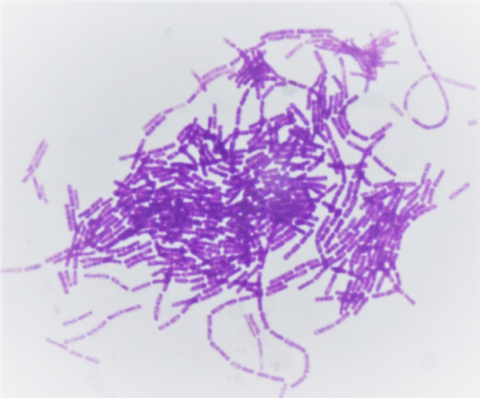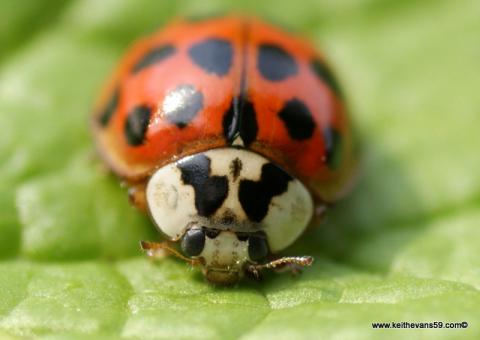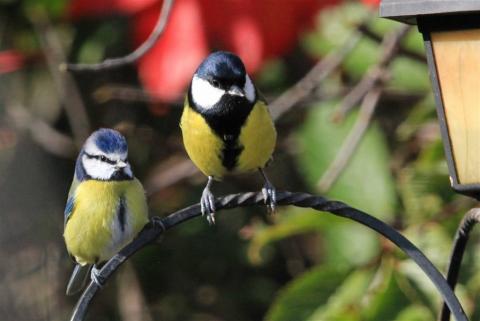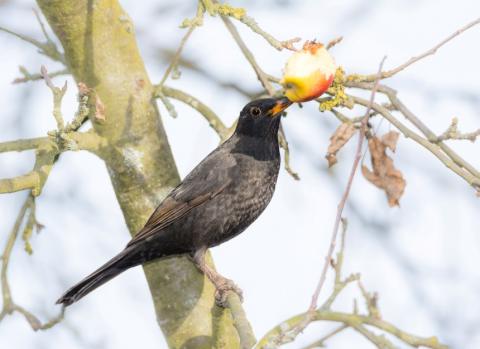21 April 2021
Dr Cate Williams: IBERS, Aberystwyth University.
- The environmental issues and emerging resistance to pesticides has prompted the consideration of alternative strategies, including biological agents.
- Toxins from bacteria have been incorporated into biopesticide formulations as efficient, specific and biodegradable active ingredients.
- Predatory insects such as parasitoid wasps and ladybirds have been successfully implemented in controlled conditions but may pose a risk of becoming invasive or may be unsuitable for use in open fields.
- Birds perform integral ecosystem services including the control of pests in crops, augmenting the environment by providing hedgerows or nesting boxes can encourage them into the area to prey on crop pests.
Pesticides are an integral part of agriculture and food security, facilitating the production of safe, high-quality food to feed our livestock and growing human population. The use of pesticides has allowed more food to be produced per given area of land, increasing yields and farm revenue. Whilst the area of land that these chemicals are being applied to has almost doubled in the UK over the past 25 years, the total weight used has almost halved – suggesting the development of more effective compounds. When used correctly, pesticides are an important agricultural tool, however, they are not without their problems. After application pesticides may leach into the surrounding environment, particularly watercourses, causing diffuse contamination. This may result in the pesticides reaching non-target species be that animals or plants, and causing damage, this, in turn, has the potential to decrease biodiversity and destabilise ecosystems. In addition to the environmental implications, some pesticides can also have adverse effects on humans, causing inhalation or skin injuries. With strict controls on the development and use of pesticides, biological or integrated pest management (IPM) strategies have gained great traction with the view to reducing reliance on chemicals. Such strategies use natural predators of target pests which selectively consume the insects whilst also making strategic use of pesticides and systematic monitoring of plants/crops. Such strategies aim to reduce the risk of environmental and human health issues associated with pesticide use, in addition to combating pesticide resistance and ensure a safe, secure and profitable food supply. Indeed, some biopesticides have experienced an increase in popularity in the UK in recent years, with formulations using bacterially derived toxins seeing an increase in use of between 68 and 86%.
The biological control of pests involves the use of other organisms, these may be microbes, parasites, predatory insects and even small animals, such as birds. These organisms vary depending on the target pest and are most effective when applied to protected crops, although some have been used in the field as well. The use of bio-controls presents the opportunity to reduce reliance on pesticides, reducing the risk of resistance and offering ongoing activity as they reproduce by themselves. However, some bio-controls do require a reasonable investment, and are not an instant or short term solution as there is often a time lag whilst the organisms establish themselves. The most obvious limitation with biocontrols is their use in the field – as conditions in the crops become sub-optimal the predator will leave, this may be when the target pest population begins to decline when the predatory population becomes too large or due to upsets when the field is managed. For this reason, biocontrols are most commonly seen in controlled environments such as glasshouses, but that’s not to say they can’t be adapted for use in field crops. A potential biocontrol organism must meet several criteria before being considered for development: It should be highly specific and effective against the target pest; be culturable and quick to propagate; formulations should have a reasonable shelf life and stability and be harmless to humans and non-target organisms.
Microbes
Microbes such as bacteria and fungi may be used in bio-controls as well as parasitic organisms, all of which specifically target certain pests. The bacterium Bacillus thuringiensis (B. thuringiensis) naturally resides in the soil (as well as foliage and water) and produces several toxins that target invertebrates. These endotoxins are crystalline proteins that through a cascade of events, eventually insert themselves into the cell membrane of the insect leading to death. It is documented that many different insects are susceptible to B. thuringiensis, including butterflies and moths, fruit flies, leafhoppers, cockroaches and the two-spotted spider mite in addition to some parasites such as Haemonchus sp. (barber’s pole worm), Nematodirus and Toxoplasma sp. These bacterial endotoxins are highly specific and are harmless to humans and other vertebrates as well as beneficial insects. Along with other biodegradable ingredients, B. thuringiensis proteins have been incorporated into a variety of commercial applications as an environmentally friendly option for pest control. However, their biodegradability becomes their main disadvantage as the endotoxins are vulnerable to several environmental factors such as pH, temperature and sunlight. To combat this, different encapsulation approaches have been adopted to protect and extend the shelf life of sprayable formulations. Development of these protective mechanisms will improve their efficacy and adoption in formulations, as currently, their presence in the global pesticide market is as low as 2%, although this formulation has been well received in the UK with usage between 2017-19 increasing by 86%.
Predatory insects
Another more widely used method of biocontrol is the use of predatory insects, larger, carnivorous organisms that selectively prey on pest species. An interesting example is found in parasitoid wasps, a large superfamily of insects that use the body of a smaller insect, the host, to incubate and hatch their eggs. Inevitably, hatching leads to death for the host which may be a pest of agricultural importance. Vitally, parasitoid wasps pose no threat to humans with females possessing a large, harmless ovipositor at the end of the abdomen which is often mistaken for a stinger. As a biocontrol agent, the aphid-eating Aphidius species is one of the more successful, being widely used in greenhouses and other controlled environments. Studies have found that A. colemani in particular, achieved a control rate extremely similar to the standard pesticide, Marathon 1% G in greenhouse-grown chrysanthemums. However, parasitism levels ranged widely, from 48.9% to 83.4% between plots indicating variation in individual efficacy. Authors also note that the use of parasitoid wasps is much safer than a chemical pesticide, both in terms of human health and the environment, with good dispersal distances as the wasps search for prey. As the use of parasitoid wasps has developed, the cost of their use has also fallen, this species is relatively easy to rear commercially but distribution can be problematic, as shipping can result in deaths.
Perhaps the most well-known biocontrol organism is the ladybird which actively predates on aphids, whiteflies, plant lice and scale insects. There are many different species of ladybird, each of which preys on a specific species, the most commonly used in European biocontrols is the Harlequin ladybird (Harmonia axyridis). The Harlequin ladybird is a seasonal predator and attacks multiple species of aphid pests in field and orchard crops. When introduced in North America, this insect showed rapid dispersal over long distances, eventually becoming one of the most common ladybird species in the USA. In controlled studies, the percentage reduction in aphid populations varies widely, from 65 to 99.5% showing a linear relationship with ladybird: aphid ratio – the more ladybirds, the larger the reduction in aphids. In particular, the release of H. axyridis in the larval stages has been successful, with aphid populations on strawberry plants decreasing by 85% over a 29-day observation period, however, when a mix of larvae and adults were used the results were more inconsistent. A reduction in the aphid population of 80% after 7 days was observed, but this bounced back up to just a 38% reduction at day 21 and then back down to 78% at day 35, likely due to the cycle of hatching larvae and adults moving away from the habitat. A possible solution to the ladybird simply flying away, is the use of naturally occurring flightless strains. Comparing the release of flightless vs. flying A. axyridis, a study found that both the levels of and fluctuations in aphid populations were significantly smaller with flightless ladybirds compared to those with wings. Populations treated with flying ladybirds achieved a maximum reduction of 83% whilst flightless ladybirds achieved a reduction of 98%. Another study supports this result, finding more flightless ladybirds on eggplants for a longer time period than flying ones, as well as significantly more effective aphid control. Other novel approaches may include the use of pheromones for attracting and maintaining ladybirds in a crop, although the cost and feasibility of this method are yet to be evaluated.
An EIP Wales project aims to evaluate the efficacy and cost effectiveness of implementing predatory insects as biocontrols in soft fruit as compared with conventional methods. The project will investigate their suitability for use on two Welsh fruit farms, whilst developing pest identification skills to help farmers get the most out of the biocontrols.
The primary challenge with the introduction of insect predators is the potential for a foreign, non-native species to escape into the surrounding environment and out-compete native insects. A prime example of this is found in H. axyridis which poses a significant threat to other local, aphid-eating insects, in fact, this species has become so successful in the USA that it is now considered a pest and human nuisance. It’s high fecundity, effective predation and good dispersal rates, all excellent qualities in a biocontrol agent, also make H. axyridis a successful invasive species. Whilst often the predator dies off once the initial pest population is destroyed, sometimes the predator will find a more susceptible target or move into the surrounding environment, as has been the case with the Harlequin ladybird.
To avoid issues surrounding the introduction of invasive alien species we might consider changing and enhancing the environment in the field to attract natural predators. This may be through the use of hedgerows, trees or uncultivated margins around fields. One study looked at the use of ryegrass margins around wheat plots finding that in the margins, the population density of ladybirds (3.5 per m2) was significantly higher than in the wheat plots (1.5 m2). But, after cutting the ryegrass the ladybirds were forced to move into the wheat fields. Three and eight days after cutting, aphid numbers in the wheat decreased significantly – by 19.9% and 53.6%, respectively. Such evidence suggests that minimally managed margins around fields could encourage ladybird populations, after which, cutting the grass could push ladybirds into crops to control aphid populations.
Birds
Most of the aforementioned strategies are best suited to use in controlled environments, i.e. glasshouses, and simply wouldn’t be feasible or effective in an open field, but that is not to say that biocontrols cannot be used on croplands too, mostly through providing habitats for local wildlife and supporting biodiversity; A key example of this is seen in insectivorous birds. Many bird species native to the UK are insectivorous or omnivorous, from the resident meadow pipit to seasonal swallows and swifts, in particular, many UK birds rely entirely on insects to feed their chicks. As such, the provision of safe nesting sites in the form of trees or hedgerows that will not be disturbed by cutting or harvesting near the target crop can encourage insectivorous birds into the area to play a role in pest management. Numerous studies in both natural and agricultural habitats show not only that birds reduce insect populations, but also that plants often respond with higher growth rates or crop yields. Attracting insectivorous birds to agricultural areas may also aid in the conservation of declining species, provide cultural ecosystem services like wildlife watching and respond to consumer preferences – potentially conferring economic advantages to farmers.
A study in California used caterpillars in a Brassica crop to engage naturally occurring local bird populations and over 7 hours, resident birds consumed up to 80% of caterpillars, with an average of 24%. Authors noted that the chance of pest removal was significantly higher in areas with hedgerows. These results suggest that birds may be more helpful in responding to pest outbreaks than in controlling pests at a basal level. The prevention of pest outbreaks is an essential ecosystem service on any farm, and the rapid response of birds to outbreaks could be advantageous. Studies using artificial nesting boxes for insectivorous birds have also yielded interesting results. Upon the addition of boxes in apple orchards, a reduction in arthropod pests of 52% was observed with a 17% reduction in the probability of pest occurrence. The study carried out in Spain found annual variation in nest box occupancy of 25-33% with the most common occupants being great tits, blue tits and the occasional common redstart. Different nesting species preyed on different pests, with blue tits preferring arthropod pests and feeding nestlings at a faster rate than the great tit, which preferred butterfly larvae and caterpillars. This work also suggests that pollinator numbers remain unaffected by bird predation and that these birds have large foraging ranges, covering the entirety of the orchard (up to 24 ha). Another experiment based in an American apple orchard found that allowing birds access increased predation of larvae of harmful moths from 11 to 46% - this was enhanced by increasing the proportion of seminatural habitat nearby - achieved by retaining old trees and hedgerows around agricultural land.
Other ecosystem services such as the effect of raptors on rodent populations are not as well studied, but existing results suggest that birds of prey do contribute to the control of mammalian pests. Perches placed around soybean fields in Australia increased the number of raptors around and over the fields, which in turn decreased house mouse populations. Similarly, a Spanish study found that the provision of appropriate nest boxes enhanced the density of common kestrels and barn owls around arable land which in turn significantly reduced common vole numbers.
Despite all of the observed benefits that birds have to offer in an agricultural setting, they are not without their drawbacks. Many birds are frugivores – feeding mainly on fruit – or consume seeds that may be a threat to cereal crops. In which case, it is important to evaluate the net effect of encouraging birds into the area, in some cases, for example where high value, energy-rich fruits are concerned the overall effect may be negative and the strategy unsuitable. That said, measuring both ecosystem services and disservices can be highly complex, with some being much easier to observe and quantify, such as direct damage to a crop whereas services such as pest control are not as obvious.
Summary
Whilst pesticides are an essential part of maintaining a safe and high-quality food supply, they are also highly damaging to the environment, human health and serious issues are now arising as a result of pesticide resistance. To reduce our reliance on chemical pesticides, one option is to look at biological agents for pest control - a living organism with the ability to manage pests. A good example of a microbial agent is the endotoxin from B. thuringiensis which is already used in some commercial products. This toxin is highly specific and effective, but is also sensitive to the environment and biodegradable, as such, the toxin requires protective coatings to maintain function. Possibly one of the better-known strategies is the use of predatory insects, such as ladybirds, to control pest species on plants and crops. In controlled environments ladybirds are effective in managing aphid populations, with reductions of up to 99.5%. Studies also suggest that in the field, ryegrass margins may also encourage ladybirds into the area, then, after cutting the insects will move into the crops and predate on pests. However, very few predatory insects are suitable for application in crops in the field, not least of all because they are likely to leave croplands and spread into the local area. This can lead to issues with the foreign, invasive species out-competing native insects and reducing biodiversity. Another option for biocontrol may be birds, by enhancing the surrounding environment through the use of hedgerows or nest boxes to encourage insectivorous birds to nest and manage pests. Great and blue tits have proven to be effective in managing caterpillars and arthropod pests and can be encouraged onto farmland through the provision of nest boxes. As well as for pest control, supporting native birds helps to increase biodiversity in local areas and may encourage cultural ecosystem services such as bird watching.




